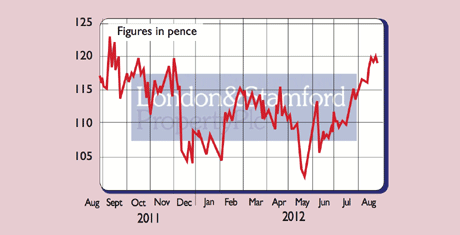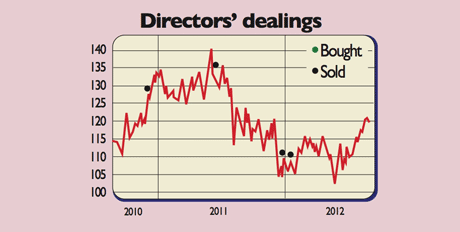Shares in focus: A property firm that inspires confidence
London & Stamford is a rare gem in a sector full of potential danger, says Phil Oakley.
London & Stamford is a rare gem in a sector full of potential danger, says Phil Oakley.
The business
London & Stamford is a British property investment and management company. It has a property portfolio worth around £860m, which is broadly diversified across five areas: distribution warehouses (19%), City of London offices (17%), south-east offices (13%), central London residential (29%) and the Meadowhall shopping centre near Sheffield (22%). The company is a real estate investment trust (Reit). This means that it does not pay tax on its rental income or any capital gains from selling rental properties. It also has to pay out 90% of its rental income in dividends to shareholders.
The history
The firm was set up by Raymond Mould and Patrick Vaughan in 2007 to exploit opportunities in a distressed British market. Backed with money from their previous ventures, and a contribution from General Electric, they set about raising £285m from outside investors.
MoneyWeek
Subscribe to MoneyWeek today and get your first six magazine issues absolutely FREE

Sign up to Money Morning
Don't miss the latest investment and personal finances news, market analysis, plus money-saving tips with our free twice-daily newsletter
Don't miss the latest investment and personal finances news, market analysis, plus money-saving tips with our free twice-daily newsletter
The company began spending it in 2009. It bought the One Fleet Place office development, which was swiftly followed by a stake in the Meadowhall shopping centre. 2010 saw London & Stamford convert to Reit status and invest in distribution warehouses. During the last couple of years it has started to invest in residential properties in central London. The objective is to retain properties with good income returns. The firm also recently sold a chunk of its lower-yielding distribution assets.
The founders
Raymond Mould and Patrick Vaughan met each other on holiday many years ago. Both have long- standing reputations as canny and successful property investors. They started their first venture, Arlington, in 1976. It focused on business parks and made both men a lot of money when they sold it to BAE Systems in 1989.
The early 1990s property bust saw them re-emerge with Pillar Properties, where they made a killing from retail parks. The business was sold to British Land in 2005.
Both are big horse-racing fans Mould's horse Bindaree won the Grand National in 2002. London & Stamford paid the pair £630,000 last year.
Should you buy the shares?
We think the shares are worth buying. The track record of Mould and Vaughan inspires a lot of confidence. Both are very good at biding their time and waiting for the right opportunities. They are value investors who look to buy property assets with double-digit cash yields. This cautious approach to property investment has served investors well so far.

The property portfolio is well diversified, with a growing focus on London and the South-east. Meadowhall, on the other hand, is not a long-term holding and will probably be sold if the price is right. The distribution sector in the South-east is suffering from a shortage of capacity, which should mean that rental income can go up over the next few years. The same could happen for the company's residential property assets in central London as many people struggle to buy property for themselves.
The firm also has some good office investments occupied by quality clients, such as Unilever. However, it is set to lose Goldman Sachs as its tenant in One Fleet Place next year. The company is very prudently financed with low borrowings relative to its assets. This reduces risks for investors but at the same time gives the company plenty of firepower for investment. With banks and other property companies looking to sell assets and pay down debt, there should be some interesting opportunities coming on to the market. Investors can pick up shares in the company for around its net asset value, which represents reasonable value. The other attraction is the dividend income; the decent yield of 5.9% has scope to grow further. The shares look to be a rarity a good investment in a property sector that remains full of potential danger. Worth tucking away.
The numbers
Directors' shareholdings

R Mould: 16,000,000
P Vaughan: 18,146,010
M McGann: 3,823,795
What the analysts say
Buy: 4
Hold: 4
Sell: 4
Average price target: 114p
Key facts
Stockmarket code: LSP
Share price: 119p
Market cap: £646m
Net assets (March 2012): £639m
Net debt (March 2012): £185m
P/BV (current year estimate): 1.04 times
Yield (prospective): 5.9%
Get the latest financial news, insights and expert analysis from our award-winning MoneyWeek team, to help you understand what really matters when it comes to your finances.
Phil spent 13 years as an investment analyst for both stockbroking and fund management companies.
After graduating with a MSc in International Banking, Economics & Finance from Liverpool Business School in 1996, Phil went to work for BWD Rensburg, a Liverpool based investment manager. In 2001, he joined ABN AMRO as a transport analyst. After a brief spell as a food retail analyst, he spent five years with ABN's very successful UK Smaller Companies team where he covered engineering, transport and support services stocks.
In 2007, Phil joined Halbis Capital Management as a European equities analyst. He began writing for MoneyWeek in 2010.
-
 London claims victory in the Brexit wars
London claims victory in the Brexit warsOpinion JPMorgan Chase's decision to build a new headquarters in London is a huge vote of confidence and a sign that the City will remain Europe's key financial hub
-
 The reinvention of the high street – and how to invest
The reinvention of the high street – and how to investThe high street brands that can make shopping and leisure an enjoyable experience will thrive, says Maryam Cockar